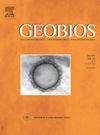下白垩统下沟组反鸟目鸟类的骨组织学
IF 1.6
4区 地球科学
Q2 PALEONTOLOGY
引用次数: 0
摘要
本文描述了甘肃长马地区下白垩统下沟组5个反鸟目鸟类标本的骨组织学特征。采集的标本分别为:3只豚鼠(Avimaia schweitzerae) (IVPP V25371、IVPP V31956和GSGM-04-CM-007)、棘蝇(Qiliania graffini) (GSGM-04-CM-006)和诺维斯(Novavis pubisculata) (IVPP V31957)。本研究的目的是描述在一个生态系统中共存的反鸟目鸟类的属内变异(在Avimaia)和分类间变异。所有五个标本的股骨皮质主要由平行纤维骨组成,血管密度相对较低。三个Avimaia标本均有2-3条血管管,且有不对称的生长标记,表明皮层漂移。祁连菌有8条纵向维管,其中5条集中在皮层的一个区域。虽然骨骼的大体解剖和复合元素的融合表明形态成熟,但既没有生长标志,也没有外周层(OCL),也没有内周层(ICL)。与其他标本相比,Novavis的股骨具有编织平行复合体的一些区域和更高水平的血管性(存在14条纵向通道)。虽然该标本在大体解剖上形态不成熟,但股骨具有发育良好的OCL和ICL。这些结果强调形态成熟和骨组织成熟之间的反鸟氨酸偏移。OCL的发育似乎与形态成熟脱钩,在某些情况下,在骨骼完全融合之前形成,而在其他情况下,则在骨骼完全融合之后形成。这些标本在大小上相似,但在生长标记的数量上差别很大,从没有到两个不等。这表明发育可塑性和多样化的生长策略,并使解释对鸟的相对年龄和生长阶段的尝试复杂化。本文章由计算机程序翻译,如有差异,请以英文原文为准。
Osteohistology of enantiornithine birds from the Lower Cretaceous Xiagou Formation
We describe the osteohistology of five enantiornithine bird specimens from Lower Cretaceous Xiagou Formation deposits of the Changma locality in northwestern Gansu Province, China. Samples were taken from the femora of: three specimens of Avimaia schweitzerae (IVPP V25371, IVPP V31956, and GSGM-04-CM-007), Qiliania graffini GSGM-04-CM-006, and Novavis pubisculata IVPP V31957. The objective of this study is to describe intrageneric variation (in Avimaia), and intertaxonomic variation among enantiornithine birds coexisting in an ecosystem. All five specimens have a femoral cortex composed mainly of parallel fibered bone with relatively low vascularity. All three Avimaia specimens have 2–3 vascular canals, and asymmetrical growth marks, indicating cortical drift. In Qiliania there are eight longitudinal vascular canals, five of which are concentrated in one region of the cortex. Although the gross anatomy of the skeleton and fusion of compound elements indicates morphological maturity, neither growth marks, an outer circumferential layer (OCL), nor an inner circumferential layer (ICL) are present. The femur of Novavis has some regions of a woven parallel complex and a higher level of vascularity relative to the other specimens (14 longitudinal channels present). Although this specimen is morphologically immature based on gross anatomy, the femur has a well-developed OCL and ICL. These results emphasize the enantiornithine offset between morphological maturity and osteohistological maturity. Development of the OCL appears to be decoupled from morphological maturity, in some cases forming before the skeleton has fully fused, and in others well after. The specimens are similar in size but vary considerably in the number of growth marks present, from none to two. This suggests either developmental plasticity and diverse growth strategies and, complicates attempts to interpret relative age and growth stage in enantiornithines.
求助全文
通过发布文献求助,成功后即可免费获取论文全文。
去求助
来源期刊

Geobios
地学-古生物学
CiteScore
3.30
自引率
6.20%
发文量
28
审稿时长
6-12 weeks
期刊介绍:
Geobios publishes bimonthly in English original peer-reviewed articles of international interest in any area of paleontology, paleobiology, paleoecology, paleobiogeography, (bio)stratigraphy and biogeochemistry. All taxonomic groups are treated, including microfossils, invertebrates, plants, vertebrates and ichnofossils.
Geobios welcomes descriptive papers based on original material (e.g. large Systematic Paleontology works), as well as more analytically and/or methodologically oriented papers, provided they offer strong and significant biochronological/biostratigraphical, paleobiogeographical, paleobiological and/or phylogenetic new insights and perspectices. A high priority level is given to synchronic and/or diachronic studies based on multi- or inter-disciplinary approaches mixing various fields of Earth and Life Sciences. Works based on extant data are also considered, provided they offer significant insights into geological-time studies.
 求助内容:
求助内容: 应助结果提醒方式:
应助结果提醒方式:


